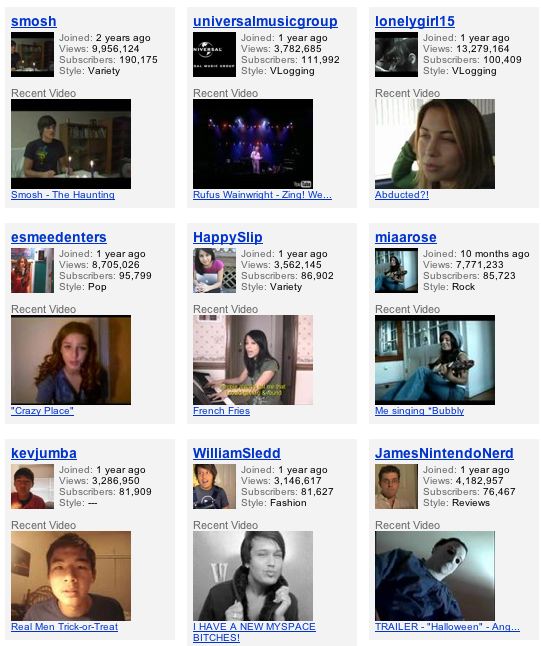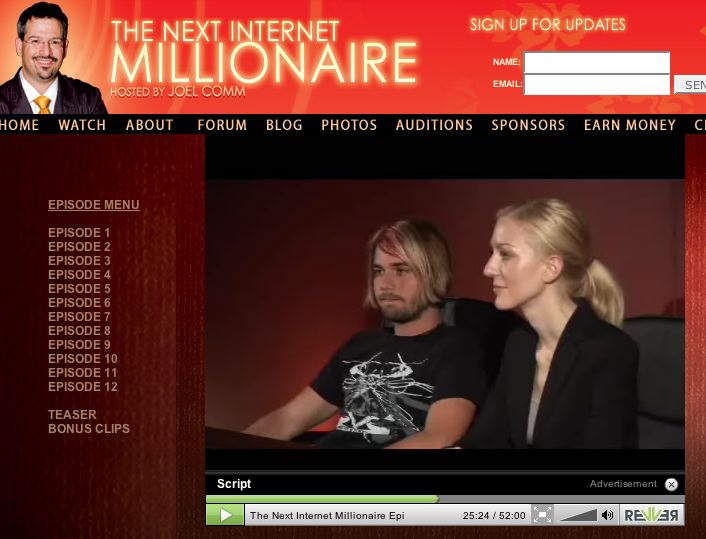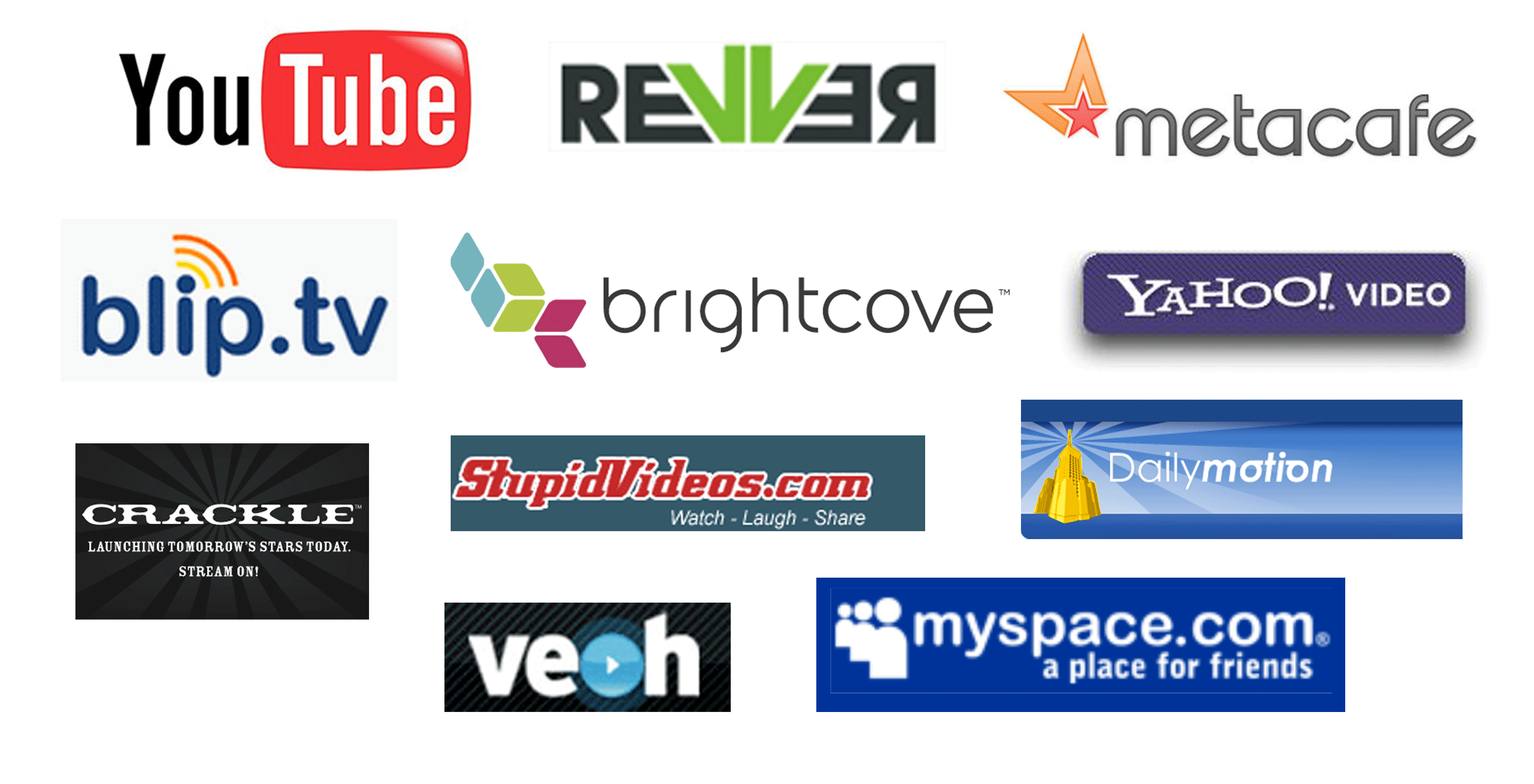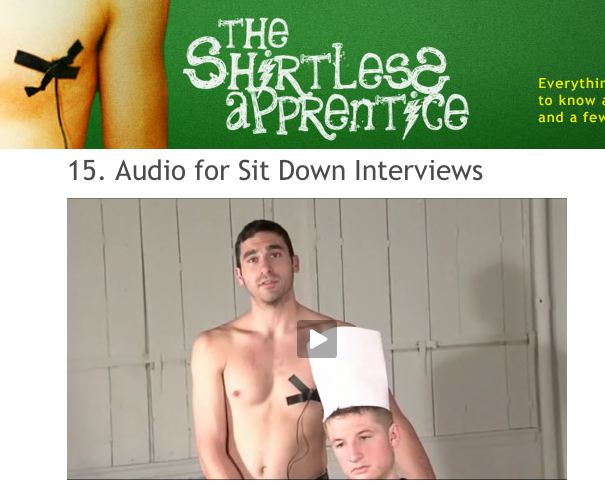Advertising Age archived my article, so you need a subscription to access it now.
Click “more” below for the full article.
Continue reading Ten Things a Marketer Should Know About Online Video
Advertising Age archived my article, so you need a subscription to access it now.
Click “more” below for the full article.
Continue reading Ten Things a Marketer Should Know About Online Video
 Today’s Wall Street Journal has an article by Raymund Flandez called “Lights, Camera, Sales: How to Use Video to Expand Your Business in a YouTube World.” It’s positioned on the front page as “Small Business: How to Use Video to Grow.”
Today’s Wall Street Journal has an article by Raymund Flandez called “Lights, Camera, Sales: How to Use Video to Expand Your Business in a YouTube World.” It’s positioned on the front page as “Small Business: How to Use Video to Grow.”
I’ve got some issues with the piece, and not just because Flandez didn’t interview The Viral Video Genius. The article lists some nice case studies — from Blendec’s popular “Will it Blend” series (which drove sales up 500% to $40 million) to a clever “Free Range Root Beer” campaign by All Natural Main Root. I hadn’t heard of this series, yet the late-night breakin by root-beer activists is clever and only mildly over acted. But…
But there are a few things in the WSJ article that make my BS alarmgo off. Buckle up, readers, this is an must-read WillVideoForFood post.
 The WSJ reports that Moe’s Southwest Grill did a video contest where it received 40 submissions and got 211K visitors. That’s not bad vital signs for a video contest, although I’d guess the cost per lead was exponentially more than it would cost to run a decent paid-search campaign– given the fixed costs of promoting and running the contest. Hopefully the video entries were viewed in other places beyond the contest site (a vital element to the performance of a campaign unless it’s a strict “lead generation” or transactional direct-response play).
The WSJ reports that Moe’s Southwest Grill did a video contest where it received 40 submissions and got 211K visitors. That’s not bad vital signs for a video contest, although I’d guess the cost per lead was exponentially more than it would cost to run a decent paid-search campaign– given the fixed costs of promoting and running the contest. Hopefully the video entries were viewed in other places beyond the contest site (a vital element to the performance of a campaign unless it’s a strict “lead generation” or transactional direct-response play).There’s a big difference between vaguely recalling a Toyota video preroll ad that tortured me as I an anticipated an SNL clip, versus buying a painting on eBay because the artist posted videos of herself creating the piece (Valentina Trevino).
Ahh. I feel better now that I’ve done the standard “arrogant blogger throws mud at WSJ writer who didn’t interview him” drill. Now it’s time for some basic reminders, and this should be required reading for anyone that got googly eyed from reading the WSJ article:
KEY VIRAL VIDEO REMINDERS
 You gotta throw a lot of spaghetti on the wall and watch what sticks. It’s still hard to say what people like about online videos (although funny, short, visceral and “big finish” are important ingredients). I’ve done more than 500 online videos and still can’t predict what will sail or sink. For every “Vals Art Diary” there are thousands of overproduced (and sometimes even clever) marketing videos that are buried in the bowls of YouTube. For every “Farting in Public” (which just cracked 4 million views) there’s a “Prisoner of Best Buy” (a video I shot this morning, but is doomed to never be seen beyond 20K times because I actually like it). So what’s that mean? Experiment.
You gotta throw a lot of spaghetti on the wall and watch what sticks. It’s still hard to say what people like about online videos (although funny, short, visceral and “big finish” are important ingredients). I’ve done more than 500 online videos and still can’t predict what will sail or sink. For every “Vals Art Diary” there are thousands of overproduced (and sometimes even clever) marketing videos that are buried in the bowls of YouTube. For every “Farting in Public” (which just cracked 4 million views) there’s a “Prisoner of Best Buy” (a video I shot this morning, but is doomed to never be seen beyond 20K times because I actually like it). So what’s that mean? Experiment. Be sure to decide the objective of the campaign and remember that objective when it’s time to assess performance. I’ve seen too many companies begin with a goal to get e-mail addresses, for instance, and then get giddy about total views and the homepage feature on Eefoof (yes, Marquis, it’s finally dead- I checked). Similarly, some brands plunge into online video simply for the public relations value, and then lament low views. Who cares about visits to your stupid brochureware site if you got the views and press (even if it’s consumer-generated media) you were after? People don’t need to lick a Coke billboard to be compelled to buy colored sugar water with red wrappers instead of blue. Dang I’m full of metaphors today. Is anyone writing this stuff down?
Be sure to decide the objective of the campaign and remember that objective when it’s time to assess performance. I’ve seen too many companies begin with a goal to get e-mail addresses, for instance, and then get giddy about total views and the homepage feature on Eefoof (yes, Marquis, it’s finally dead- I checked). Similarly, some brands plunge into online video simply for the public relations value, and then lament low views. Who cares about visits to your stupid brochureware site if you got the views and press (even if it’s consumer-generated media) you were after? People don’t need to lick a Coke billboard to be compelled to buy colored sugar water with red wrappers instead of blue. Dang I’m full of metaphors today. Is anyone writing this stuff down?For those of you with short attention span, I’ve summarized this post in this visual of a video virus magnified 2 billion times:
Sidebar: Flandez interviews David Meerman Scott, author of “The New Rules of Marketing and PR” in this interesting video that features an obnoxious preroll. I hadn’t heard of Scott, but was pleased to discover his books and blog.
 Remember how major advertising agencies handled the Internet? Let’s recap their 5 stages of grief:
Remember how major advertising agencies handled the Internet? Let’s recap their 5 stages of grief:
But the Internet agencies did the same thing when it came to paid search. So it’s bad all over.
Now, dear Madison Avenue, I will predict your five stages of dealing with online video. Fortunately, you have some progressive chap that’s smart enough to read WillVideoForFood, so you might have the forethought to skip a stage or two.
I could see the look of disdain and fear in the eyes of the agency attendees when I spoke at AdTech last week about doing Mentos ads for $2-$5,000. Then I reminded them (partially to avoid getting booed off the stage) of some good news for agencies.
We consumers aren’t consuming less. We’re just breaking into content-consumption niches and online communities that shape our thinking and purchase decisions. That actually creates a need for more content, and that can make an agency fees actually grow.
 I also cautioned that the model I used for Mentos isn’t scalable. As an amateur videographer I dealt directly with the product director. That’s not scalable. For a brand to develop creative content for a variety of different online audiences and channels, the product team needs to hire a variety of lower cost creators. Twelve amateurs instead of a giant “one size fits all” television ad with exotic models and expensive shoots in Hawaii? That creates more — not less — of a need for an agency.
I also cautioned that the model I used for Mentos isn’t scalable. As an amateur videographer I dealt directly with the product director. That’s not scalable. For a brand to develop creative content for a variety of different online audiences and channels, the product team needs to hire a variety of lower cost creators. Twelve amateurs instead of a giant “one size fits all” television ad with exotic models and expensive shoots in Hawaii? That creates more — not less — of a need for an agency.
So how can your big agency stay ahead of this and avoid the pain you felt when the Internet and paid search became important? It’s as simple as five different kinda steps:
We’re approaching the tipping point for a fantastic time in the evolution of media consumption!
 Consumers are in control, but advertising is the currency because we consumers are too cheap to pay. Reality television and online video is exploding because we’re tired of perfection: scripted shows, polished ads, good looking models. We want to see people like us, and content that speaks to us individually. Advertisers can help pave the road, or wait until it’s built and buy billboards along the highway. What’s your agency going to do?
Consumers are in control, but advertising is the currency because we consumers are too cheap to pay. Reality television and online video is exploding because we’re tired of perfection: scripted shows, polished ads, good looking models. We want to see people like us, and content that speaks to us individually. Advertisers can help pave the road, or wait until it’s built and buy billboards along the highway. What’s your agency going to do?
Could you be worth less than one dollar a month to StupidVideo? The site offers a premium service that allows you to enjoy its videos ad-free for 99 cents a month (on annual subscription, and it eliminates streaming ads only).
This begs the question- is that what it’s worth to a viewer to skip ad (customer-value pricing), or is that an economic decision (the average visitor consumes so few videos that StupidVideo would rather a dollar than the ad revenue they could make off that visitor’s eyeballs?
Grant- it might simply be a gimmick to provide ad-sensitive viewers and garner some modest revenue from those viewers that are so opposed to ads that they’d go elsewhere otherwise. Certainly the approach is unique in the online-video arena. I’m surprised more sites don’t have a pay-for-no-ad model, but quite curious how they’d price it. After all, an active site visitor to YouTube might watch a few dozen videos in a day. YouTube would be foolish to let that visitor buy their way out of ads unless the customer fee offset the anticipated ad revenue (or, again, you were just afraid they’d go elsewhere if ads persist).
Yaro Starak of “Entrepreneur’s Journey” feels otherwise, but I’m betting on CharlesTrippy as the winner of the first-ever internet reality show, “The Next Internet Millionaire.”
 For those who haven’t followed the show, we’ve seen 12 hopefuls eliminated “survivor” style over 12 web-only shows, and it’s down to two people. Charles Trippy, a college student and popular online video “weblebrity.” And Jaime Luchuck from Toronto who has a bio I’d summarize but I just fell asleep reading it. What time is it? What was I writing about?
For those who haven’t followed the show, we’ve seen 12 hopefuls eliminated “survivor” style over 12 web-only shows, and it’s down to two people. Charles Trippy, a college student and popular online video “weblebrity.” And Jaime Luchuck from Toronto who has a bio I’d summarize but I just fell asleep reading it. What time is it? What was I writing about?
The winner is the one that has the most success with their entrepreneurial ideas.
Now you could argue I’m biased here. I know Trippy. We’ve done collab videos. He’s been to my house. The little knucklehead mentioned my name on the last episode (episode 12) of “The Next Internet Millionaire” while pitching his concept.
But here’s why I believe Trippy’s product is going to far outsell Jaime’s book
 I think I’m featured in Trippy’s DVD, although I can’t recall what wisdom I spewed. And I sent him the tape because I was too lazy to digitize it. So the only way for me to find out what I said was to buy the series. Not only am I not getting paid to endorse or promote his product, the little bitch made me pay full retail price for it. And I just bought all three DVDs.
I think I’m featured in Trippy’s DVD, although I can’t recall what wisdom I spewed. And I sent him the tape because I was too lazy to digitize it. So the only way for me to find out what I said was to buy the series. Not only am I not getting paid to endorse or promote his product, the little bitch made me pay full retail price for it. And I just bought all three DVDs.
Now here’s the sweetener, and Trippy doesn’t know I’m making this special “once in a lifetime” offer to WillVideoForFood readers and Nalts viewers to help him sell his DVDs. Anyone that purchases the series and sends Trippy the confirmation e-mail to him (ctrippy@gmail.com) will get to appear in a Trippy video on his popular YouTube channel. All you have to do is send a photo attached to your confirmation with a jpeg of your photo and a mention of this offer. By virtue of this, he pretty much has no recourse but to honor it. Details soon in a video.
Here’s where you pick up Trippy’s DVD series, called “Viral Video Fever.” Get a copy before Nov. 14 to be eligible for an introductory discount and to be in his video. Or go buy the book. Whatever.
 TubeMogul now facilitates simple uploading to multiple videos sites that include such recent additions as StupidVideo and Crackle. This image shows the collection of sites that now accept videos via TubeMogul.
TubeMogul now facilitates simple uploading to multiple videos sites that include such recent additions as StupidVideo and Crackle. This image shows the collection of sites that now accept videos via TubeMogul.
There are other sites through which you can upload multiple videos, but TubeMogul saves your username and passwords, and tracks metrics. The site apparently is going to also track other performance metrics, which will allow creators to monitor performance and advertisers to provide simple reports for their clients.
I’m not getting kickbacks from TubeMogul to mention them, but I’ve covered the site several times because I can’t believe other creators aren’t using the free tool. It’s saved me time, and kept me uploading to sites that I otherwise might forget or skip because of the painful act of repetitive uploading. I wouldn’t be surprised if second-tier sites start paying TubeMogul just to gain access to its users video content. Certainly I’d prefer to see TubeMogul’s revenue come from the hosting sites instead of us video creators.
This blog has been too consumed with YouTube and Nalts lately, and I want to get back to WillVideoForFood’s roots. Finding ways to improve the production of online video, marketing via online video, and learning tips to promote amateur and promotional content.
 Yesterday I spoke with Paul Kontonis of For Your Imagination. I thought I was an expert in online-video marketing, but I was humbled by Paul’s knowledge of how to get views beyond YouTube. “For Your Imagination” produces a series of fairly high-quality serialized content (some of which has developed into television series). So it doesn’t all apply to us amateurs. But he’s partnered with sites like blip.tv and identified ways to distribute via iTunes and other outlets and still retain advertising revenue. I’m planning on doing a more indepth interview with him soon.
Yesterday I spoke with Paul Kontonis of For Your Imagination. I thought I was an expert in online-video marketing, but I was humbled by Paul’s knowledge of how to get views beyond YouTube. “For Your Imagination” produces a series of fairly high-quality serialized content (some of which has developed into television series). So it doesn’t all apply to us amateurs. But he’s partnered with sites like blip.tv and identified ways to distribute via iTunes and other outlets and still retain advertising revenue. I’m planning on doing a more indepth interview with him soon.
Paul has business partners and funding, and employees a team of production people as well as viral junkees (some freelance) that help promote and distribute the programs they produce. If there’s another business model like it, I haven’t seen it.
Check out this show to learn production while getting bits of humor. It’s “The Shirtless Apprentice.” The poor guy wears a lav stuck to his chest with gaffer tape, and there’s some comedy mixed with solid video-production tips. Personally, I’d love even more humor, but it certainly beats the majority of talking heads out there. I’m adding it to my RSS, and there are already more than 2-dozen episodes on these important topics:
I debated heavily before posting this, because this blog is supposed to be a review of the fun world of viral video and marketing (not an advertisement for my services). That being said, I think some of you readers may be interested in how I work with sponsors.
As you know, I advocate that brands participate in consumer-generated media, but many have invested hundreds of thousands, and have seen little in return. Here’s a presentation I recently gave for some clients of Atlanta-based interactive agency, Spunlogic. It takes you through a number of ways your brand can enter this space cost efficiently — from contests to partnering with known creators.
Background
Earlier this summer, I read The Secret. The big idea (while not being entirely new) is that you can attract things you want, if you ask for something and have an unwavering belief that it can happen. My day job as a Marketing Director pays well, but we live out of our means. So I decided to pursue an additional $4-$5,000 a month. And it’s been working. I’ve created several videos through XLNTAds and here’s a recent example for GPSManiac (it has nearly 40,000 views and was rated among the top videos of the day when it posted). I’m working on scheduling some promotional workshops because I believe most agencies and brands are still in the dark ages in this arena. October happens to be a slower month because a few of my promotional videos have been delayed to November and December.
So this month, I’m offering a “sale” for custom entertainment/promotional videos.
 You can promote your product or service for $2,000 flat fee (I’ve charged $1,500-$5,000). You’ll get a video you own for use on your own website, and a guarantee of no less than 20,000 views via my channels (I’m able to do that primarily thanks to YouTube). I perhaps should charge a higher premium because these are implied endorsements, and I don’t ever want to fatigue my kind, devoted viewers. But I enjoy making them and getting additional income. Two thousand dollars comes to no more than a dime a view, or $20 CPM (cost per thousand), which is the price YouTube charges for its new “InVideo” ads that appear briefly in the first 10 seconds of the video.
You can promote your product or service for $2,000 flat fee (I’ve charged $1,500-$5,000). You’ll get a video you own for use on your own website, and a guarantee of no less than 20,000 views via my channels (I’m able to do that primarily thanks to YouTube). I perhaps should charge a higher premium because these are implied endorsements, and I don’t ever want to fatigue my kind, devoted viewers. But I enjoy making them and getting additional income. Two thousand dollars comes to no more than a dime a view, or $20 CPM (cost per thousand), which is the price YouTube charges for its new “InVideo” ads that appear briefly in the first 10 seconds of the video.
I hope you can appreciate that I tend to be selective about the brands I promote. I typically avoid unknown startups, brands that don’t fit my personality, or anything to do with healthcare marketing (since that’s a conflict of interest). My favorite sponsor is Mentos (see Mentos example that they ran as an ad on Google Video and Break) because they are very hands off the creative and it’s a great brand. If you’re interested, please send a note to kevinnalts at gmail.com with the subject header “PROMOTIONAL VIDEO.” That ensures it gets my attention among the myriad of spam I get.
Here’s how it works:
As I’ve always said, anyone can get into this space. It helps when you have a sizable audience (I’m fortunate to have large following via YouTube) because that increases the views to your videos. At the same time, I have to walk a careful balance, because I never want to violate the trust of my viewers or promote so frequently that they stop watching.
I know some of my fellow YouTubers have also begun to do promotional videos (see Charles Trippy’s recent video which has already been viewed more than 75K times), and some have charged more or less. A few are new at this, and are happy to promote a fun brand in exchange for free product.
I look forward to your feedback. Do you think this is a fair deal? Any advice about ensuring brands meet their goals without compromising viewers experience? I want to hear from you. We’re still working things out on the WillVideoForFood forum, but that will eventually be a place we can compare and debate approaches.
 The folks behind Xlntads.com (the contest site that connects brands and video creators) were good enough to let me hijack their studio for my fake election videos (“Embarassing TV Appearance” and “Embarassing TV Appearance part 2“). Famed YouTuber, Renetto, makes a cameo in these.
The folks behind Xlntads.com (the contest site that connects brands and video creators) were good enough to let me hijack their studio for my fake election videos (“Embarassing TV Appearance” and “Embarassing TV Appearance part 2“). Famed YouTuber, Renetto, makes a cameo in these.
So the least I could do was talk about Xlntads for a series being featured on iMediaConnection.com. Check it out.
You can also hear from the Acting CEO of Xlntads, Neil Perry, who talks about how marketers can get quality video content cost efficiently by leveraging amateurs. The former McDonald’s executive also plays my campaign manager in the above-mentioned videos.
Disclaimer: I’m leading the creator advisory board for Xlntads and I’ve entered a number of their contests. I’m a big believer on new models that connect creators with marketers, because I think it’s a great match. Unless you happen to be a creator working for The YouTube Underground. Then you’re likely to eat the marketer. And marketers don’t like to be eaten.
 In today’s YouTube “highest rated comedy videos of the day,” my videos represent spots 5, 6 and 8. YouTube, as you probably know, represents the vast majority of online viewing. So does this mean I produced the funniest videos on the planet this weekend? Of course not.
In today’s YouTube “highest rated comedy videos of the day,” my videos represent spots 5, 6 and 8. YouTube, as you probably know, represents the vast majority of online viewing. So does this mean I produced the funniest videos on the planet this weekend? Of course not.
I have an advantage because I have a loyal following of “subscribers” that watch my videos and rate them highly — presumably because we share a sense of humor. When they rate the video highly, it propels into the “top rated” comedy page where it sits besides videos that are often far funnier (this Barats & Bereta video “Olympian” is a good example). But sometimes not- there are some YouTubers that have been around since the beginning and may not be hysterical but have fans that have basically developed parasocial relationships with them over time.
While on the “best” or “most watched” sections, the videos pick up secondary audiences, and sometimes get lifted and embedded on other sites (for a tertiary audience). So this has a resulting impact on total views.
Naturally, funnier videos exist buried on YouTube, where maybe 60-100K videos are posted each day. You might have posted one. Sorry you aren’t landing on these pages, but there’s hope.
The most important variable to getting seen on YouTube is the channel and the base of loyal subscribers. I could upload these same videos to my alias accounts and get virtually no views.
So how do you build a channel of loyal subscribers? Patience, decent videos, active participation in the community (reply, watch, collaborate) and hopefully get featured on YouTube’s coveted homepage. My lil’ YouTube career took off with Viral Video Genius and Farting in Public, both of which were featured on the YouTube homepage (thanks, editors).
In this video, titled “How I Cheat YouTube,” I describe some of the things creators (and marketers) can do to help get their videos viewed. Parenthetically, this video is the #1 highest rated “how to” video though I launched it just yesterday. Again, thanks subscribers!
What this raises is something interesting… the value of a channel, and more importantly the value of quality (not just quantity) of loyal subscribers. Marketers will have trouble developing this on their own, and that’s where creators can help (if it’s done tastefully). It’s why I’m reluctant to “sell out” my channel to any advertiser, and why I want to ensure my product-placement or consumer-generated ads are funny. I’ve got two or three on ice right now because I haven’t yet made them effective and entertaining.
YouTube is really the only place you can find this phenomenon online, but it’s not unlike the increased cost of an ad in a more popular television show.
Anyway, this blog is really directed at passionate creators and enthusiastic marketers. But I know some of my loyal viewers read and comment. Thanks so much, gang. Without you I’d be living in obscurity and making my reluctant neighbors watch my videos.